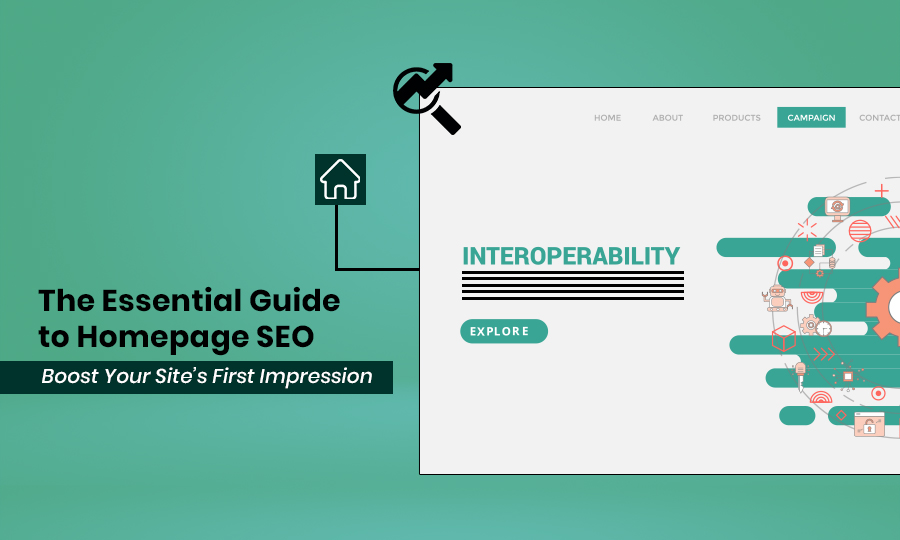Your homepage has a significant impact on how users and Google view your brand. A recent study reveals that Homepages overall outperformed inner pages when it came to ranking #1 on Google for their main keywords (54.8% vs 45.2%). In today’s digital world, your website’s first impression begins with the homepage—the art of optimizing your homepage SEO to attract more traffic, improve rankings, and convert visitors into customers.
An impressive homepage acts as the framework of your online image. It displays a connection to Google Search, navigates to key landing pages, and guides your target audience through smart internal links. However, many businesses ignore the potential of this homepage, so they concentrate their SEO efforts mainly on service pages or blog posts. In reality, the homepage is the anchor of your entire SEO ecosystem the base that increases online exposure, authority, and user belief.
Do you know every detail matters, including page speed, descriptive alt text, title tag, meta description, internal links among webpages, and branded keyword placement? If you want your website to be at the top of search engine result pages, you need to develop a prominent strategy of SEO for Homepage.
In this article, you’ll discover the definition and relevance of homepage SEO with the detailed steps of optimizing SEO to boost rankings, user experience, and your website’s efficacy. Let’s delve deeper and learn the Homepage SEO Best Practices with a how-to steps guide.
What Is Homepage SEO?
SEO stands for Search Engine Optimization. It helps search engines understand your website content and helps your website rank higher on search engines. The homepage is the first page that your target audience will see. That’s why you need to optimize SEO for homepage and choose a professional design for the main page. When you develop an SEO strategy to improve your homepage more efficiently and rank higher on serach engines, this entire process is called homepage SEO optimization strategy.
How Does Google Search Evaluate Your Homepage Differently?
You need to know how Google will see your homepage’s efficacy and what the basic factors are. It will help you understand the Google algorithm for ranking pages. And you can generate more new ideas for performing homepage seo more effectively.
E-E-A-T Signals Specific to Homepages
- Google judges your homepage using E-E-A-T standards: Experience, Expertise, Authoritativeness, and Trustworthiness.
- Your homepage must show real-world experience through client logos, project portfolios, or case study highlights. Display expertise with clear credentials, certifications, and team qualifications prominently. Build authoritativeness by featuring media mentions, awards, and industry partnerships.
- You need to establish trustworthiness through visible contact details, a secure HTTPS connection, privacy policies, and genuine customer testimonials.
- Unlike inner pages, homepages receive stricter E-E-A-T scrutiny because they represent your entire brand’s legitimacy. Google’s quality raters specifically evaluate whether your homepage demonstrates legitimate business operations and industry standing.
Brand Entity Recognition and Homepage Relevance
- Google thinks of your homepage as the digital ID card for your brand. The search engine generates a knowledge graph linking your brand name to your homepage, industry, products, and reputation signals. Your brand entity recognition is strong when Google sees consistent mentions of your business name online linking to your homepage.
- Your homepage helps Google understand what your brand offers and who you serve. Your business name, industry descriptions, and structured schema markup will help identify your entity. Google tracks branded search volume—how many people search specifically for your company name.
- Higher branded searches raise your homepage’s authority for branded and non-branded keywords.
Homepage Engagement Metrics- That Most Important Ranking Factor
- Google monitors how visitors interact with your homepage differently from other pages.
- If people immediately leave, your homepage doesn’t match search intent according to the bounce rate.
- How long users spend on your homepage shows their interest.
- The click-through rate to internal pages shows that your homepage guides visitors.
- Core Web Vitals measure loading speed, interactivity, and visual stability—critical for homepages since they’re often the first impression.
- Homepages must be mobile-friendly because most users find brands on phones.
- Google also tracks pogo-sticking—when users return to search results quickly after clicking your homepage, it displays dissatisfaction. Google sees high engagement metrics as proof that your homepage meets user specifications.
Why SEO for Homepage Is Important?
Homepage SEO is the most essential online marketing tactic. It usually earns the most links, holds the most authority, and helps search engines understand your brand. Here, you get the most effective points that help you to understand the need to optimize your homepage seo strategy.
- The Homepage Paradox: Brand Hub vs. SEO Landing Page
Your home page serves as both a hub for your brand and an SEO landing page. People will learn about your brand and find their way to important pages with the help of the home page. You can uplift your homepage ranking in search engines and help people find what they need quickly.
- Homepage SEO Differs from Other Page Optimization
The home page sets the tone for the whole site and targets broad, important keywords, while the inner pages focus on specific topics. An important focus is on useful content, easy navigation, and internal links that take you to home pages. When you optimize your home page correctly, your search engine rankings go up overall.
- The Ripple Effect: How Homepage Authority Impacts Entire Site Performance
A strong homepage raises the authority of your website. Google sees the homepage as the most important page, so when it gets a higher rank, other webpages do too. This means that a well-optimized homepage can have a positive ripple effect on the website’s performance. By focusing on homepage SEO, you can improve the visibility and ranking of all pages on your website.
- Set Realistic Expectations for Homepage Rankings
A site can rank for relevant keywords, but it takes significant time to get to the top of search results. A good SEO strategy needs useful keywords, internal links, and user-generated content. You need to combine a successful homepage SEO strategy with relevant primary keywords, add relevant internal links, and an accessible design for screen readers. Moreover, you should focus on search intent to deliver content that your visitors find helpful.
How to Optimize the Homepage for SEO- Step-by-Step?
The homepage is the most essential page of the website. So here you will learn the most successful SEO strategies for your homepage.
- Strategic Keyword Research for Homepage SEO
Keywords are those specific terms your target audience uses to serach your particular service or products. So, you need to find out those important keywords and input them into your homepage content.
How to Do Keyword Research for Homepage SEO?
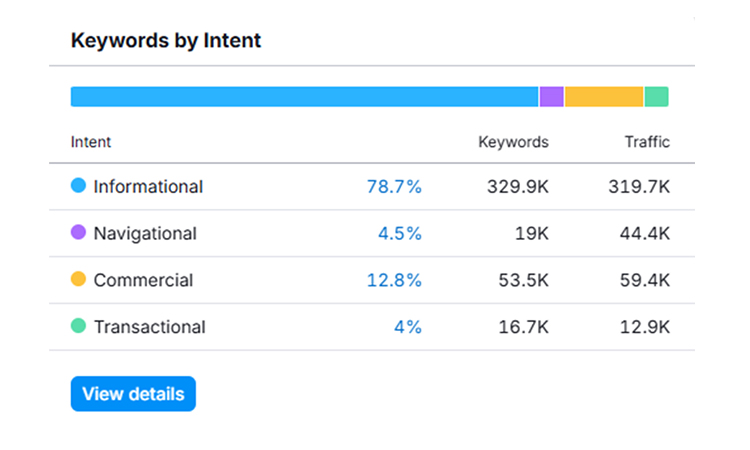
Identifying Brand, Navigational, and Commercial Keywords
To begin your keyword research, group three types of relevant keywords.
- Branded keywords include your company name and variations—these build authority.
- Navigational keywords help users find specific pages.
- Commercial keywords show buying intent, like “best” or “affordable.”
Moreover, you can take help from Google Keyword Planner to discover search volumes for each category. This free tool shows you which target keywords get the most visitors.
Competitor Homepage Analysis for Keyword Gaps
- Go to the homepages of your top competitors and look at where they put their target keywords. So you can use keyword research tools like SEMrush or Ahrefs to see their ranking terms.
- Look for relevant keywords they’re missing—these are your opportunities.
- Check their meta titles, H1 tags, and homepage content for important keywords you can target better.
Balance Keyword Search Volume with Brand Alignment
- Don’t chase high-volume keywords that don’t match your brand.
- Your primary keyword should reflect what you actually offer.
- Pick important keywords that fit with your unique value proposition, even if they don’t get a lot of searches.
Best Keyword Research Tools for Homepage SEO
- Google Keyword Planner
- Semrush
- Mangools KWFinder
- Ahrefs
- Moz Keyword Explorer
- Ubersuggest
What Keywords Should You Target on Your Homepage?
- Primary Brand Keywords and Variations-Your exact business name is your main branded keyword. Include common abbreviations as related keywords in your homepage content.
- Target Keywords related to Specific Industry-Target category terms like “digital marketing agency” or “accounting firm.” These help Google understand your business type and show you in relevant searches.
- Problem-Solution Keywords for Your Niche-Include keywords that describe customer problems you solve. For example, “fast website loading” or “affordable tax preparation.”
- Local SEO Keywords for Homepage Optimization-Add location-based keywords like “plumber in Boston” if you serve local customers. This targets geographic searches effectively and improves your homepage SEO impacts.
Let’s Find Important Keywords Practically
First, you need to type your primary keyword on Google and let Google search your related keywords. Like this-
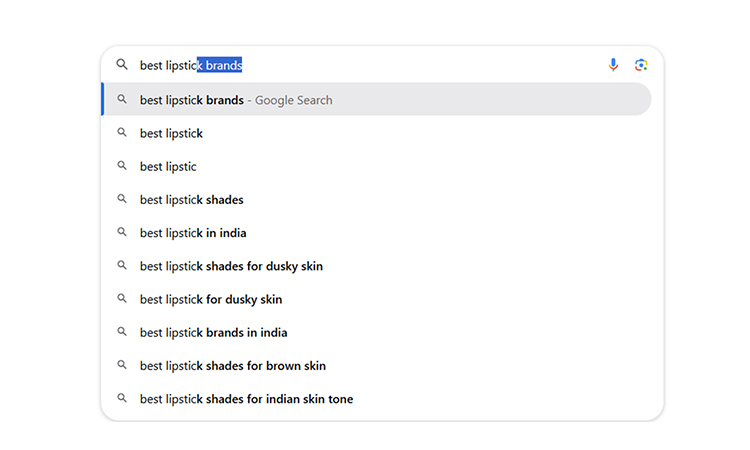
Moreover, you can go to the “People also ask” section and get an idea of how users search and what is trending.

Here I give you step-by-step keyword research with the help of the Mangools KWFinder tool
First, you need to create a free account in Mangools KWFinder.
Then you need to put your main keywords in the search bar, select your target location, and your language.
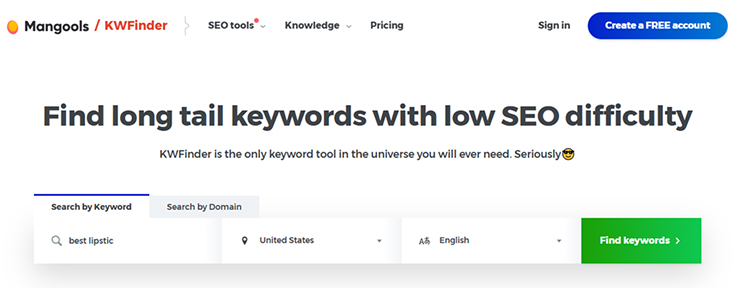
You get in-depth details for your primary keyword, like this-
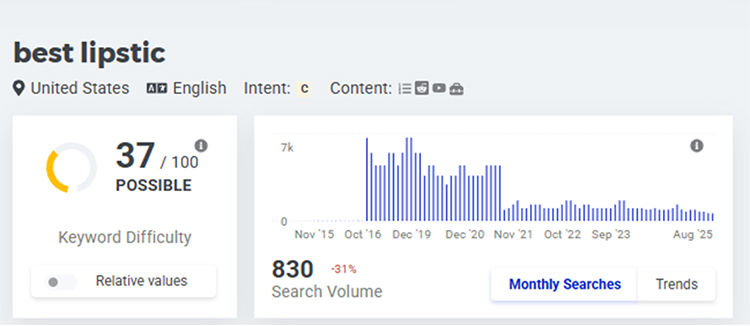
More in-depth keyword ideas with search intent, keyword volume, and difficulty-

These are keyword choosing metrics you need to follow to improve keyword rankings for homepage seo-
| Keyword Factor | Definition | How to Choose / Use for Homepage |
| KD (Keyword Difficulty) | Measures competition to rank for a keyword | Select moderate difficulty if your domain is new, high difficulty if authority is strong |
| Volume | Average monthly search queries | Choose keywords with enough traffic potential to drive visitors |
| SERP Features | Search Engine Results Page elements like featured snippets, videos, maps | Evaluate if you can target featured snippets or rich results for added visibility |
| CPC (Cost Per Click) | Average advertising cost per click | Higher CPC often indicates high commercial value — good for primary keyword targeting |
How to find out which keywords your Rivals Use but You Don’t?

You can go to SEMrush-> Keyword Gap-> add your website URL and your competitors’ URLs to find your keyword gap.
How Do You Avoid Keyword Stuffing While Optimizing Your Homepage?
- Natural Keyword Integration in Homepage Content-You need to write for humans first. So you can mention your primary keyword in the first paragraph naturally. Then you should spread important keywords throughout different sections without forcing repetition.
- Semantic Keyword Clusters and LSI Terms- Moreover, you need to use related keywords and synonyms instead of repeating the same target keywords. Google understands semantic relationships, so “SEO services” and “search engine optimization approaches” both count.
- Keyword Density Myths Debunked-Forget the old 2-3% keyword density rule. Focus on comprehensive homepage content that covers your topic thoroughly. Mention important keywords where they make sense naturally, not by counting percentages.
- Craft the Perfect Homepage Title and Meta Description
Title tag and a good meta description are very important to optimize your homepage seo.
What Makes a High-Converting Homepage Title Tag?
Brand-First vs. Keyword-First Title Structures
First, you need to select between two proven formulas to optimize your homepage.
- Brand-first: “Apple—iPhone, Mac, iPad, and More” puts your brand upfront.
- Keyword-first: “Digital Marketing Agency | WebCraft Solutions” matches your focus keyword.
Brand-first is effective for well-known organizations. Keyword-first helps new businesses show up in search results for important keywords.
Character Limits and Truncation Strategies
- Keep your title under 60 characters to prevent Google from cutting it off in search results.
- Aim for under 600 pixels to ensure full display.
Example: “Boston Plumber | 24/7 Emergency Service” (44 characters)
Emotional Triggers in Homepage Titles
Moreover, you need to add words that make people want to do something. Use “Trusted,” “Award-Winning,” “Fast,” or “Affordable.” These trigger emotional responses and increase clicks from search results.
Example: “Award-Winning Web Design Agency—Transform Your Brand”
Title Tag Formulas That Work in Google Search Results
Your homepage should target your hardest-to-rank focus keyword in the title tag. Try these proven formulas:
- Formula 1: [Service] | [Benefit] | [Brand]
- Formula 2: [Brand] – [What You Do] for [Target Audience]

How Do You Write a Meta Description That Drives Clicks?
The Anatomy of Compelling Meta Descriptions-The ideal meta descriptions should be between 50 and 160 characters for optimal display. So, you can begin with your focus keyword in the first sentence. Add your unique value proposition. End with a clear call to action. This clear structure maximizes clicks from search results.
Including Value Propositions and CTAs-Your meta tags must answer “Why choose us?” Include specific benefits like “Free Consultation” or “Same-Day Service.”
End with action phrases: “Get Started Today” or “Request a Quote.”
Example: “GlowUp Beauty treatments for radiant, healthy skin. 1,000+ happy clients. Book your free consultation today.”
Meta Description Length Optimization
- The sweet spot is 50–160 characters.
- Mobile displays fewer characters than a desktop. Front-load important information.
- You should be careful when you optimize your homepage because Google may rewrite descriptions that don’t match the content of the page.
A/B Testing Meta Descriptions for Performance
Test different value propositions monthly. Change one element: the CTA, benefit statement, or keyword placement. Track click-through rates in Google Search Console. Keep the winning version. Even a 0.5% CTR improvement drives significant traffic gains.
Should Your Homepage Title Tag Include Your Location or Service?
Yes, you need to include your location or service in the homepage title tag if you target local audiences. It helps Google understand your business area and improves local search rankings visibility. Let’s explore how strategically you can input these-
Local Business Homepage Title Optimization- For small companies in your area, always include your city or service area. This helps you get to the top of the area search results.
Example: “Smith & Sons Roofing | Licensed Roofers in Miami, FL”
E-Commerce vs. Service Page Title Strategies
E-commerce sites should highlight product categories: “Men’s Shoes & Sneakers – Free Shipping | ShoeMart.”
Service businesses need location and specialty: “Corporate Tax Accountant | Chicago CPA Firm.”
Multi-Location Business Title Tactics
For multiple locations, keep the homepage broad: “Premium Car Detailing | Serving 15 Cities Nationwide”
So you need to create separate landing pages for each location with specific meta tags. This will target specific areas’ search engine rankings.
- Best Homepage Content Optimization Strategy
How will people know about your products and services if you don’t have content? In other words, the information on your site is what makes it SEO-friendly. The more SEO-friendly your content is, the better your homepage SEO strategy will be. According to 79% of content marketers, content marketing generates high-quality leads.
The Myth of Content Length on Homepages
- Your homepage preferences are different content than a blog post. Most homepages work best with 400-600 words. This length gives search engines enough context to understand your business.
- Many people think longer content always ranks better. That’s not true for homepages. Studies show homepage content between 100 and 1,000 words performs well, with 400-600 being the sweet spot.
- Most importantly, you need to focus on quality over quantity. Your homepage should answer three questions quickly: What do you do? Who do you serve? Why should visitors trust you?
Balance Visual Design with Text Content
- You should write informative blog posts or content. Your home page’s content should maintain a well-organized structure. As much as your content is adding value to your website, it will help to improve your rankings for users and search engines.
- Search engines can understand your site better if it has text on it. To improve your site, you need both visuals and well-written text. You can put important text near strong visuals.
- Use short paragraphs between images. Break up content with white space. This keeps readers engaged while giving search engines valuable content to index.
- Your homepage shouldn’t look like a blog post filled with paragraphs. It should blend attractive visuals with strategic text placement.
Above-the-Fold vs. Below-the-Fold Content Distribution
Most of the users see above-the-fold content first without scrolling. Place your main message and primary keywords there. Put your value proposition in the first screen. Search engines pay attention to content placement. They know users focus on visible content first. Below-the-fold sections work great for detailed service descriptions and testimonials. This structure satisfies both user intent and search engine requirements.
What Type of Homepage Content Works Best for Google Search?
Hero Section Optimization with Keyword Integration- Your hero section sits at the top of your homepage. It’s the first thing visitors see. Include your primary keyword in the hero headline naturally. Write a clear subheadline that explains what you offer. Don’t stuff keywords here. Make it conversational and human. Example: “Professional Web Design Services for Growing Businesses” beats “Web Design, Web Designer, Website Development Company.”
Value Proposition Statements That Include Target Keywords- Your value proposition tells visitors why they should choose you. Weave relevant keywords into this statement naturally. Focus on benefits, not features. Example: “We help small businesses increase organic traffic through proven SEO strategies” includes keywords while staying readable. This approach works for users and search engines at the same time.
Service/Product Overview Sections- Create clear sections for your main offerings. Each section should target different keywords naturally. Use descriptive headings that include service names. Write 50-100 words per service explaining the benefits. Link these sections to other pages where visitors can learn more. This structure helps search rankings while guiding users to key pages.
Problem-Agitation-Solution Frameworks- Start by identifying your customer’s problem. Explain why this problem matters. Then present your solution. This framework keeps visitors engaged while naturally incorporating keywords. Search engines favor content that matches user intent. Problem-solution content directly addresses what people search for.
How Do You Structure Homepage Content for Both Users and Search Engines?
Information Hierarchy and H1-H6 Heading Structure
- Your homepage needs one H1 tag containing your main keyword.
- Use H2 tags for major sections like “Our Services” or “Why Choose Us.” H3 tags work for subsections within these areas. This hierarchy helps users scan content.
- It also informs search engines which content is most important. Moreover, don’t skip heading levels. Don’t jump from H2 to H4. Keep the structure logical and clean.
Content Blocks That Enhance User Experience and Homepage SEO
Break your homepage into distinct content blocks. Each block should serve one purpose. So you should create blocks for services, testimonials, benefits, and calls to action. Moreover, you need to add reasonable spacing between blocks. Naturally, add important keywords that are relevant to each block and add more context. It also helps search engines index different sections properly. Your target audience can easily scan and find the information they need.
Where Should You Incorporate Testimonials for Maximum SEO Impact?
Social Proof Placement Strategies- You need to establish testimonials strategically across your homepage. Add 2-3 testimonials near your main call-to-action buttons.
Moreover, you can highlight client names and companies when possible. For both visitors and search engines, real names make it easier to trust you. Include testimonials after explaining your services. This reinforces your claims with proof. Competitor analysis shows top-ranking homepages always incorporate testimonials in multiple locations. Don’t hide testimonials at the bottom. Spread them throughout your content.
Video Testimonials and SEO Benefits
- Video testimonials are one of the most important keys to improving your homepage SEO content visbility. It will engage your visitors longer than text.
- You can upload videos to YouTube first, then embed them on your homepage. This creates backlinks and additional exposure. Moreover, you need to include transcripts of video testimonials as text.
- How to Create High Quality Backlinks for Your Website?
Your homepage is the authority on your site, so it needs strong backlinks to be optimized for homepage SEO. 46.5% of digital marketers spend $5,000 to $10,000 per month on link building, and 67.5% think that backlinks greatly influence search engine rankings.
- Authority Flow and PageRank Distribution-Your homepage distributes authority to every other page through internal links. You need to get high-quality backlinks to your homepage to create a powerful flow of authority across your website. Your pages will all rank higher in search results if you use this method.
- Homepage Link Equity Impact on website- Homepage backlink increases your domain authority. This authority flows to target pages throughout your site. Your site will get more visitors and rank higher for new content if your homepage has a lot of inbound links.
- Trust Signals from Homepage Backlinks-Search engines view homepage links as valid online recommendations. When authoritative sites link to your homepage, they indicate that users can navigate to your whole website safely. This trust factor improves search intent matching across all your pages.
What Strategies Generate High-Quality Backlinks to Your Homepage?
- Digital PR and Brand Mentions-You need to generate newsworthy stories that journalists want to cover. Approach reporters with your unique data or perspectives on the industry. By default, homepage links are frequently present in brand mentions. So you need to focus on being featured in industry publications and mainstream media.
- Resource Page Link Building-Find resource pages in your industry that list helpful tools or services. Reach out to site owners, explaining why your homepage deserves inclusion. Resource pages provide relevant, high-quality backlinks that drive organic traffic.
- Partnership and Collaboration Links-Form smart relationships with businesses that do similar things. When it makes sense for both groups, swap site links. When you announce a collaboration, partner sites and review sites will easily link back to your homepage.
- Industry Directory Submissions That Matter-Not advertising directories, but respected industry sites should be where you list your business. You need to pay attention to niche-specific sites that have a lot of domain reputation. When you send these in, you get important backlinks to your site that last.
- Press Coverage and Media Mentions-Respond to journalist queries on platforms like HARO. Provide expert quotes for articles in your industry. Typically, media mentions include links to homepages, which generate referral traffic as well as backlinks.
How Do You Audit and Monitor Your Homepage Backlink Profile?
- Toxic Link Identification and Disavowal-Review your backlink profile monthly using tools like Google Search Console. Identify spammy links from low-quality sites. Create a disavow file for toxic links that could harm your rankings. Regular audits protect your homepage authority.
- Competitor Backlink Analysis-You need to research where competitors get their homepage backlinks. So you can find the gaps in your own backlink profile. Target the same quality backlinks they have. This strategy helps you compete for rankings in your niche.
- Link Velocity and Natural Growth Patterns-You should monitor how quickly you gain new backlinks. Sudden spikes look unnatural to search engines. Aim for steady, consistent backlink growth. Natural patterns protect you from penalties while building authority.
- You can check your Top Anchors at SEMrush->Domain Overview section. You need to put your main domain, and you get all the necessary details you should know.
- Anchor Text Diversity for Homepage Links-Then you can check the anchor text distribution in your backlink profile. Traffic to pages with at least one exact match anchor was at least five times higher than that of pages without. Mix branded anchors, naked URLs, and keyword anchors naturally. Too many exact-match keyword anchors trigger spam filters. You need to maintain Diversity to keep your profile looking organic.
Should You Focus on Homepage Links or Deep Links?
- Balance Homepage and Internal Page Link Building-Your link-building strategy needs both homepage and deep links. Homepage links build overall domain authority. Deep links help specific pages rank for targeted keywords. Allocate 40% of efforts to the homepage and 60% to internal pages.
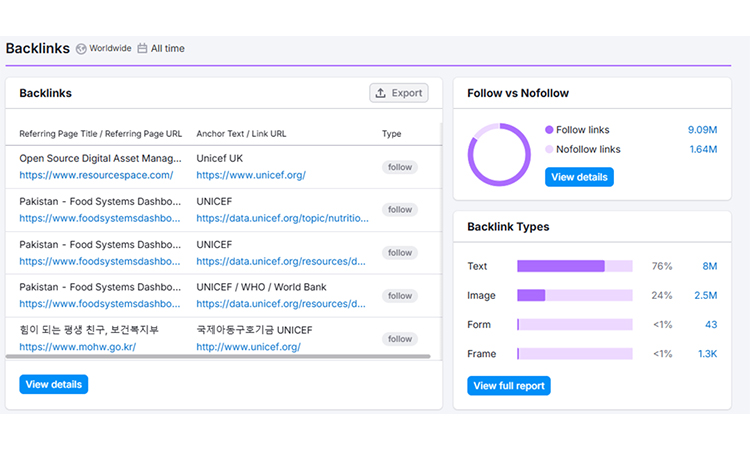
You can check your backlinks at Semrush-> Backlink Analytics tool.
- Strategic Link Building Distribution-You need to prioritize homepage links when launching a new site. So concentrate on deep links once your domain authority reaches 30+. This distribution maximizes the impact of every backlink you earn.
- When to Prioritize Homepage Backlinks-When you’re about to develop your brand, you need to acquire backlinks. If your domain reputation is less than 20, pay attention to there. When a business or service provider’s site is the main starting page, homepage links are very important.
- Technical SEO Optimization for Homepage
The most important part is to improving homepage seo is maintaining technical SEO. Here, you get the in-depth steps of implementing technical considerations for homepage SEO.
Site Architecture Is Very Important
The connections between the pages on your website are known as site architecture. A clear site structure helps search engines understand your content. It also helps mobile users find information quickly.
Your homepage sits at the top of your site hierarchy. Every other page should be reachable within three clicks from your homepage. This develops a logical flow that search engines can browse easily.
How to Create a Clear Site Structure:
- Map out your main categories on your homepage.
- Link to your most important pages directly from the homepage.
- Use descriptive navigation menus that explain what each section contains.
- Create a logical hierarchy: Homepage → Category Pages → Individual Pages
- Add breadcrumb navigation to show users where they are.
- Submit an XML sitemap to Google Search Console.
- Keep your URL structure simple and descriptive.
A clear site structure distributes link authority from your homepage to all other pages. This helps new pages rank faster when you publish them.
How Fast Should Your Homepage Load for Optimal Page Speed?
Page speed indicates how quickly your homepage loads completely. Fast loading times improve user experience and search engine rankings. Slow pages disappoint visitors and hurt your technical SEO.
Your homepage should load in under 2.5 seconds on both desktop and mobile. Speed directly affects whether visitors stay or leave immediately.
Core Web Vitals Benchmarks for Homepages
Core Web Vitals are key metrics Google uses to measure page performance. The three main metrics are Largest Contentful Paint (LCP) under 2.5 seconds, Interaction to Next Paint (INP) under 200 milliseconds, and Cumulative Layout Shift (CLS) under 0.1.
LCP (Largest Contentful Paint): This measures when your main content loads. Your homepage hero image or text block should appear within 2.5 seconds. Slow LCP happens when images are too large or your server responds slowly.
INP (Interaction to Next Paint): This indicator replaced FID in 2024 and measures how quickly your homepage responds to user clicks and taps. Keep INP under 200 milliseconds.
CLS (Cumulative Layout Shift): This key metric is visual stability. Content shouldn’t jump around while loading. Keep CLS under 0.1 to prevent frustrating layout shifts that make users click the wrong thing.
How to Improve Core Web Vitals:
- Test your homepage using Google PageSpeed Data.
- Check your scores for mobile and desktop separately.
- Focus on fixing the metric with the worst score first.
- Retest after each improvement to measure progress.
- Aim for the 75th percentile—meaning 75% of your page loads should meet these targets.
Optimize Image Without Sacrificing Visual Appeal
Image optimization reduces file sizes while keeping images looking sharp. Large images are the biggest cause of slow homepages.
Step-by-Step Image Optimization:
- Choose the right format: Use WebP for photos (50% smaller than JPEG). Use SVG for logos and icons (they scale perfectly).
- Compress images: Use tools like TinyPNG or ImageOptim before uploading. Aim for images under 200 KB each.
- Resize images correctly: Don’t upload a 3000px image if your homepage only displays it at 1200px width.
- Use responsive images: Add srcset attributes so mobile users download smaller versions.
- Set width and height attributes: This prevents layout shift when images load.
Your homepage hero image matters most. Optimize it first since it affects LCP directly.
Lazy Loading Strategies for Homepage Elements
Lazy loading delays loading images and content until users scroll to them. This speeds up the first page load, and it will improve your homepage SEO.
How to Implement Lazy Loading:
- Add the loading=”lazy” property to all images below the fold.
- Never lazy-load your hero image—it should load immediately.
- Lazy load videos, embedded maps, and heavy content blocks.
- Use the Intersection Observer API for custom lazy loading.
- Test that lazy loading works on mobile devices.
CDN Implementation for Global Audiences
A CDN (Content Delivery Network) stores copies of your homepage on servers worldwide. Users load your page from the nearest server location.
Benefits of CDN for Homepage:
- Faster loading for international visitors
- Reduced server load during traffic spikes
- Improved page speed scores globally
- Better handling of large images and videos
How to Set Up a CDN:
- Choose a CDN provider (Cloudflare, Amazon CloudFront, or Fastly).
- Sign up and add your website domain.
- Update your DNS settings to point to the CDN.
- Configure caching rules for your homepage assets.
- Test your homepage from different geographic locations.
- Monitor CDN performance in your analytics.
Cloudflare offers a free CDN plan that works well for most websites. Setup takes about 15 minutes.
What Are the Most Important Page Speed Factors for Homepages?
JavaScript and CSS Optimization- JavaScript and CSS files control your homepage design and functionality. Unoptimized code slows down loading and blocks rendering.
How to Optimize JavaScript:
- Minify your files: Remove spaces and comments to reduce file size. Use tools like UglifyJS or Terser.
- Defer non-critical JavaScript: Add the defer parameter to scripts that don’t need to run immediately.
- Remove unused JavaScript: Check what code actually runs on your homepage. Delete the rest.
- Split code into chunks: Load only the JavaScript needed for each section.
- Use async loading for third-party scripts that don’t affect initial display.
How to Optimize CSS:
- Minify CSS files: Compress your stylesheets using tools like CSSNano.
- Inline critical CSS: Put the CSS needed for above-the-fold content directly in the HTML head.
- Load non-critical CSS asynchronously: Defer loading of styles for content below the fold.
- Remove unused CSS: Tools like PurgeCSS identify styles you’re not using.
- Combine CSS files: Reduce HTTP requests by merging multiple stylesheets.
Server Response Time Improvements
Server response time (TTFB—Time to First Byte) measures how quickly your server starts sending data. Slow servers delay everything else.
Your homepage server response should be under 600 milliseconds. Anything over 1 second hurts your technical SEO for homepage.
How to Improve Server Response Time:
- Upgrade your hosting: Shared hosting is slow. Move to VPS or dedicated hosting for better performance.
- Use server-side caching: Cache your homepage HTML so the server doesn’t rebuild it every time.
- Optimize database queries: Slow database calls delay homepage loading.
- Enable compression: Gzip or Brotli compression reduces data transfer size.
- Choose a good hosting location: Host your server near most of your visitors.
- Monitor server health: Check CPU, memory, and bandwidth usage regularly.
How Do You Ensure Your Homepage Is Mobile-Optimized?
Mobile optimization ensures your homepage functions seamlessly on phones and tablets. Almost 62.54% of all organic search traffic came from mobile devices, not laptops. Mobile-first indexing means Google uses the mobile version of your website to index and rank it in search results.
Since July 2024, Google has exclusively used the mobile Googlebot to crawl all websites. Your mobile homepage is now more important than your desktop version.
Responsive vs. Adaptive Design for SEO
Responsive Design Definition: One website version that automatically adjusts to any screen size. The same HTML works on desktop, tablet, and phone. You need to choose the best responsive web design for your homepage, as it is the main entrance to your service and products you offer.
Adaptive Design Definition: Different HTML versions for different devices. The server detects the device type and sends the appropriate version.
Which Is Better for Technical SEO for Homepage?
Responsive design wins for most websites. Google recommends responsive design because:
- One URL for all devices (simpler for search engines)
- No duplicate content issues
- Easier to maintain and update
- Better for sharing content on social media
How to Implement Responsive Design:
- Use CSS media queries to adjust the layout for different screen sizes.
- Set viewport meta tag: <meta name=”viewport” content=”width=device-width, initial-scale=1″>
- Use flexible grid layouts with percentages instead of fixed pixels.
- Make images responsive by setting the max-width to 100%.
- Test on real mobile devices, not just browser tools.
- Check that the text is readable without zooming.
- Ensure buttons and links are easy to tap.
- Minimum size: 48×48 pixels (recommended by Google)
- Spacing: 8 pixels minimum between touch targets
- Critical buttons: Make them even larger (60-70 pixels).
How to Optimize Touch Targets:
- Test your homepage on actual phones to find small touch targets.
- Increase button and link padding to make them bigger.
- Add more spacing between navigation menu items.
- Make form fields taller and wider for easy tapping.
- Ensure dropdown menus work with touch (not just hover).
- Test with your thumb—can you easily tap everything?
Add Internal Links To Improve Homepage SEO
Internal links connect your homepage to other important pages on your website. They help search engines crawl your site, distribute link authority, and improve user navigate.
How to Do Internal Link Building:
- Add an internal link to your 5-10 most important pages from your homepage
- Use descriptive anchor text that tells users what they’ll find
- Place internal links naturally within your content sections
- Add navigation menu links to key category pages
- Include footer links to important pages like services and contact
- Link to high-converting landing pages above the fold
- Use buttons and text links for better visibility
- Avoid generic “click here” anchor text
- Spread links throughout your homepage content
- Update internal links when you add new important pages
- Keep total homepage links under 100 to maintain link value
- Link to both new and established pages for balance
What Technical SEO Issues Kill Homepage Rankings?
Navigation and Indexation Problems- Crawlability means search engines can access and read your homepage. Indexation means Google stores your homepage in its search index.
If Google can’t crawl or index your homepage, it won’t appear in search results at all. This is the most critical technical SEO issue.
Common Crawlability Problems:
- Blocked by robots.txt: Accidentally blocking the homepage in the robots.txt file
- Noindex tag: Meta robots tag telling Google not to index
- Server errors: 500 errors prevent Google from accessing the homepage.
- Slow server response: Timeouts cause crawl failures.
- JavaScript-only content: Content that only renders with JavaScript
- Infinite redirects: Pages that redirect in loops
How to Fix Crawlability Issues:
- Check the Google Search Console Coverage report.
- Look for “Discovered—currently not indexed” or “Crawled—currently not indexed.”
- Test your homepage URL in the URL Inspection tool.
- Review your robots.txt file at yoursite.com/robots.txt.
- Ensure the homepage doesn’t have a noindex tag.
- Fix any server errors immediately.
- Submit the homepage URL for indexing in Search Console.
How to Check Indexation:
- Search “site:yourwebsite.com” in Google.
- Your homepage should appear first in the results.
- If it doesn’t appear, you have an indexation problem.
Robots.txt Misconfigurations
Search engines can read this file and decide which pages to crawl and which ones to skip. If you make mistakes in this file, Google may block your entire homepage.
Common Robots.txt Mistakes:
- Blocking your entire site: Disallow: /
- Blocking CSS and JavaScript files that render your page
- Blocking images that provide context
- Case sensitivity errors in file paths
- Syntax errors that break the file
How to Create a Proper Robots.txt:
- Access your robots.txt at yoursite.com/robots.txt.
- Make sure it doesn’t block your homepage.
- Allow Googlebot to access CSS and JavaScript.
- Only block pages you truly don’t want indexed (admin pages, duplicate pages).
- Add your sitemap location: Sitemap: https://yoursite.com/sitemap.xml
Safe Robots.txt Example:
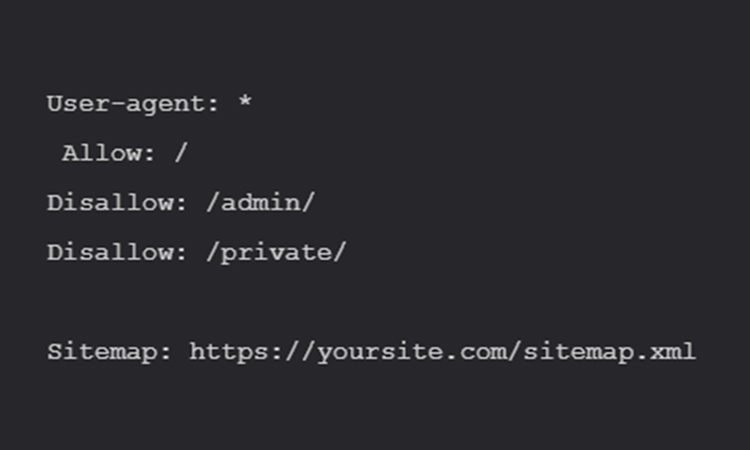
Canonical Tag Implementation
Canonical tags indicate to search engines which version of a page is the main one. This avoids duplicate content issues when you have multiple URLs for the same page.
Your homepage often has multiple URL variations:
- https://yoursite.com
- https://www.yoursite.com
- https://yoursite.com/index.html
- http://yoursite.com (non-secure)
Google sees these as different pages. This splits your ranking power across multiple URLs.
How to Implement Canonical Tags:
- Choose your preferred homepage URL (typically https://www.yoursite.com or https://yoursite.com).
- Add the canonical tag to your homepage HTML head section: <link rel=”canonical” href=”https://yoursite.com/” />
- Ensure all homepage variations redirect to your preferred URL.
- Check that the canonical tag points to itself on the homepage.
- Verify the canonical tag in the Google Search Console URL Inspection tool.
Canonical Tag Rules:
- Always use absolute URLs (full URLs with https://).
- Point to the most important version of your homepage.
- Make sure the canonical URL actually exists and works.
- Don’t canonicalize to a redirected page.
- Use consistent URLs across all canonical tags.
HTTPS and Security Signals
HTTPS encrypts data between visitors and your server. Google considers HTTPS a ranking factor and shows warnings for non-secure sites. It is very important to optimize your homepage ranking. Non-secure (HTTP) sites face ranking penalties and browser warnings that scare visitors away.
How to Implement HTTPS:
- Purchase an SSL certificate: Get it from your hosting provider or for free from Let’s Encrypt.
- Install certificate: Your hosting control panel usually has a one-click option.
- Update internal links: Convert all HTTP links to HTTPS.
- Set up 301 redirects: Redirect all HTTP versions to HTTPS.
- Update canonical tags: Switch to HTTPS URLs..
- Fix mixed content: Ensure all images, scripts, and CSS load via HTTPS.
- Update Google Search Console: Add the HTTPS version as a new property.
- Update XML sitemap: Transform all URLs to HTTPS.
- Test thoroughly: Check for broken links and security warnings.
Security Checklist:
- Valid SSL certificate (not expired)
- All pages redirect from HTTP to HTTPS.
- The HTTPS version loads without errors.
- Check security with SSL Labs (ssllabs.com/ssltest).
An SSL certificate costs $0-$100 per year. Free Let’s Encrypt certificates work perfectly for most sites.
Frequently Asked Questions
Yes, you can target a primary keyword and a few related keywords but keep the focus clear. Avoid stuffing too many keywords, it can confuse search engine rankings.
You should update your homepage every 3–6 months. Add new offers, update images, refresh meta tags, and ensure your content matches current trends and user intent.
You can start by checking for broken links, slow loading speed, or outdated content. Then update keywords, improve backlinks, and submit your site for reindexing on Google Search Console.
Let’s Quickly Wrap Up
So, we are at the end of our discussion about optimizing your homepage SEO. I hope you found these tips helpful to increase your website’s visibility and attract more traffic. Remember, you have to regularly monitor and update your homepage SEO strategies to stay ahead of the competition.
Though you can audit your homepage SEO, if you take any professional SEO services, they can provide helpful information and recommendations customized to your specific needs. So don’t think too much; go and optimize your homepage SEO to improve your site’s first impression.

